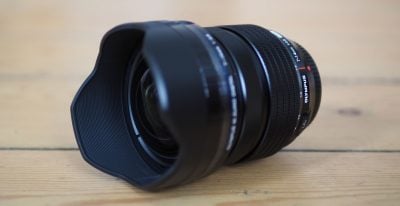Olympus 7-14mm f2.8 review
-
-
Written by Gordon Laing
In depth
The Olympus M Zuiko Digital 7-14mm f2.8 Pro is an ultra wide angle zoom for the Micro Four Thirds format. Officially announced in May 2015, the 7-14mm offers an equivalent range of 14-28mm when mounted on an Olympus or Panasonic mirrorless body, along with a constant f2.8 focal ratio.
As a member of the Olympus Pro line-up, the 7-14mm f2.8 is also weather-sealed and features the company’s ZERO coating. It joins the existing 12-40mm f2.8 Pro and 40-150mm f2.8 Pro to deliver an equivalent range of 14mm to 300mm with a constant f2.8 focal ratio and full weather-proofing. The 7-14mm f2.8 Pro was also announced alongside a fourth Pro lens, the M Zuiko Digital 8mm f1.8 Fisheye, the World’s brightest fisheye lens which I’m reviewing at the same time.
The Olympus 7-14mm f2.8 isn’t however the only ultra-wide zoom available for the Micro Four Thirds format. Early in the Micro Four Thirds story, Panasonic launched the Lumix G 7-14mm f4, a lens which shares the same coverage as the new Olympus, albeit with a constant focal ration that’s one stop slower. I own this lens, so was keen to see how it compares against the new Olympus and you can find out as my review-in-progress unfolds! Note Olympus also produced a 7-14mm f4 lens for its earlier Four Thirds DSLR system which can be adapted for Micro Four Thirds use, but the M Zuiko Digital is smaller, lighter, optically brighter and most importantly, native to Micro Four Thirds. Find out if it’s the ultra-wide lens for you!
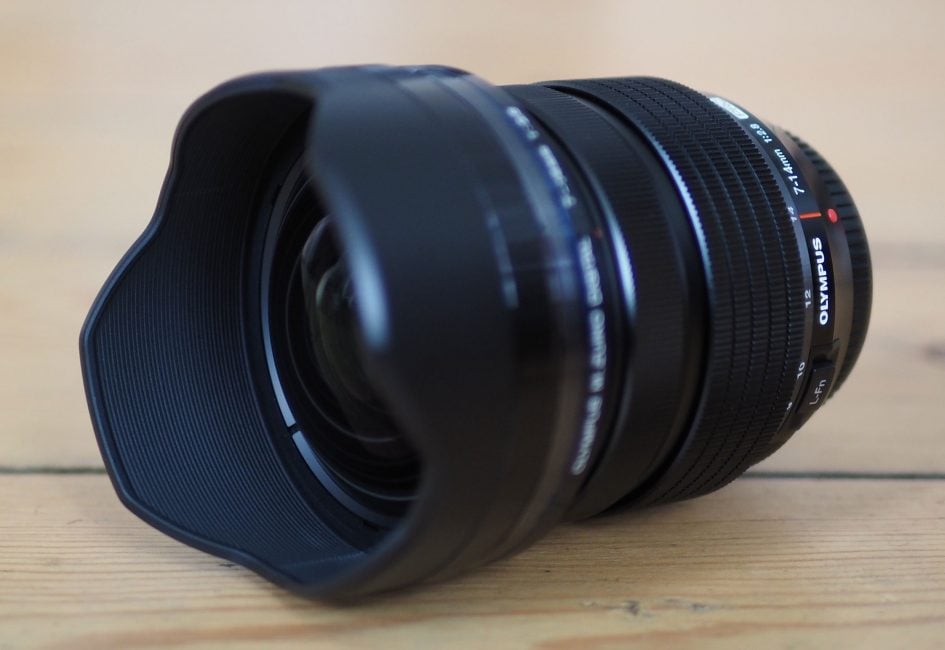
Olympus 7-14mm f2.8 design and build quality
The Olympus 7-14mm f2.8 Pro is a substantial lens which continues the smart styling of the 12-40mm and 40-150mm Pro lenses before it. The Pro line-up now looks and feels like a family with a consistent design.
Like those models, there are smooth and nicely-damped zoom and focusing rings. Like some other Olympus lenses, it’s possible to manually focus by freely turning the ring, or by pulling it back to reveal focus distance markings with physical limits to each end of the range. Both employ the same motor-assisted mechanism, but pulling the ring back switches the camera to manual focus mode with visual assistance which can include magnification and focus peaking. If you prefer to use the free-spinning ring for manual focusing, you’ll need to set the camera to Manual Focus manually. Olympus also includes a programmable function button on the barrel, near to the lens mount, by default set to AF Stop.
Autofocusing is never going to be a huge challenge for an ultra-wide lens, and as you’d expect the Olympus 7-14mm f2.8 snaps into focus quickly and without fuss. I measured the focusing speed as essentially the same as the Lumix G 7-14mm f4 when both were mounted in turn onto an OMD EM1 body. If you’re exploiting the brighter f2.8 focal ratio on the Olympus lens and focusing close to a subject there can be a little more searching, but still hardly anything to choose between them in this respect.
Physically though the Olympus 7-14mm f2.8 is quite a different beast to the earlier Lumix G 7-14mm f4. Measuring 79mm in length, 106mm in diameter and weighing 534g, it’s significantly larger and heavier than the Lumix G 7-14mm, which measures 70x83mm and weighs 300g; yep that’s almost half the weight. I’ve pictured them side-by-side below and it’s clear how much heftier the Olympus lens is, thanks to its brighter focal ratio and weather-sealing. You will however notice they share a similar design with a bulbous front-end which extends within the barrel as the focal length decreases; both also employ large lens caps which slide over the built-in hood petals and neither offers a filter thread.
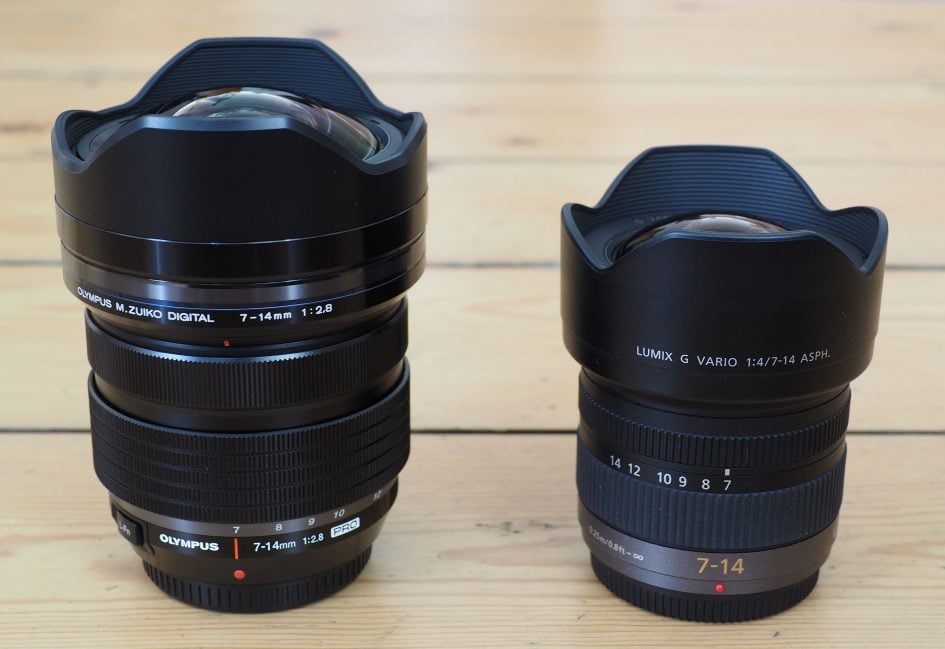
I used the Olympus OMD EM1 for most of my tests with the 7-14mm f2.8 and the pair were a well-balanced match physically, although the lens was by far the largest in my own personal collection. Mounted on a smaller body like the OMD EM5 II though, the 7-14mm f2.8 can feel more than a bit front-heavy. It’s really best-suited for the largest bodies in the MFT World, which right now means the OMD EM1 or Lumix GH4, although boosting the grip on the EM5 II certainly helps.
Switching between the two 7-14mm lenses, the Olympus version is definitely the classier one physically. The zoom and focusing rings felt smoother and less scratchy and the overall build exuded greater confidence. The Lumix G 7-14mm can feel a little plasticky in comparison and certainly doesn’t feature weather-sealing, although again it is smaller and considerably lighter, not to mention cheaper too. I’ve also always been impressed with the optical quality of the Lumix lens, so while the Olympus wins on toughness and sealing, I’m looking forward to sharing my quality results in a moment.
Before moving on though I’d like to mention the older Olympus 7-14mm f4 lens for the Four Thirds DSLR system. This model measured 87x120mm and weighed 780g, making it larger and heavier than the new Olympus 7-14mm f2.8. So while the new 7-14mm f2.8 may be heftier than the Lumix G 7-14mm f4, it’s still smaller, lighter and brighter than the old Four Thirds model, while maintaining weather-sealing and also boasting an aperture that’s one stop brighter!
Olympus 7-14mm f2.8 optics
The Olympus 7-14mm f2.8 delivers ultra wide angle coverage that’s equivalent to 14-28mm when mounted on an Olympus or Panasonic Micro Four Thirds body. The coverage matches that of the existing Lumix G 7-14mm and is illustrated below. The cheaper Olympus 9-18mm is slightly longer at each end of the range and unlike the two 7-14mm options, supports screw-in filters, although it misses out on the brighter and constant focal ratios, not to mention the weather-sealing of the 7-14mm f2.8.
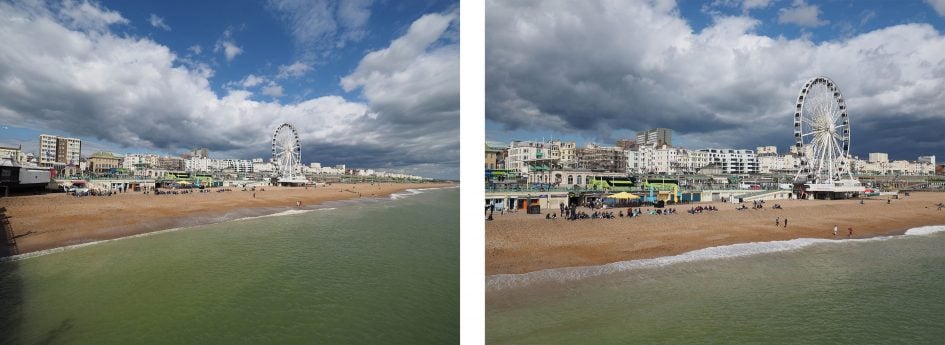
Above: Olympus 7-14mm f2.8 coverage at 7mm / 14mm equiv (left) and at 14mm / 28mm equiv (right)
The Olympus 7-14mm has a constant focal ratio of f2.8, making it a stop faster than the Lumix G 7-14mm across the entire focal range. This allows you to shoot at half the sensitivity or double the shutter speed under the same lighting conditions. It also allows you to achieve slightly shallower depth of field effects, although at ultra wide focal lengths, this will always be a minimal effect unless you’re shooting at very close range. Speaking of which, the closest focusing distance on the Olympus 7-14mm f2.8 is 20cm for a maximum magnification of 0.12x versus 25cm on the Lumix G 7-14mm, which in turn can deliver 0.08x magnification; so the Olympus lets you focus a little closer and reproduce subjects a little larger.
Here’s three examples with fairly close focusing and the kind of depth-of-field you can expect. In the first example with the lens zoomed wide to 7mm, the part of the bolt thread that’s in focus is literally at the closest focusing distance (and I feared for the vulnerable front element). In the second and third examples I’m positioned a little further away, but still focused on the foreground subject, allowing the background to blue a little as a consequence with the aperture set to f2.8. Again it’s never going to be significantly blurred with an ultra-wide lens, but the potential for blurring is still a little greater than the Lumix G 7-14mm which has a slower f4 focal ratio.

Above: 1/60, f2.8, 200 ISO, 7-14mm at 7mm (14mm equivalent)
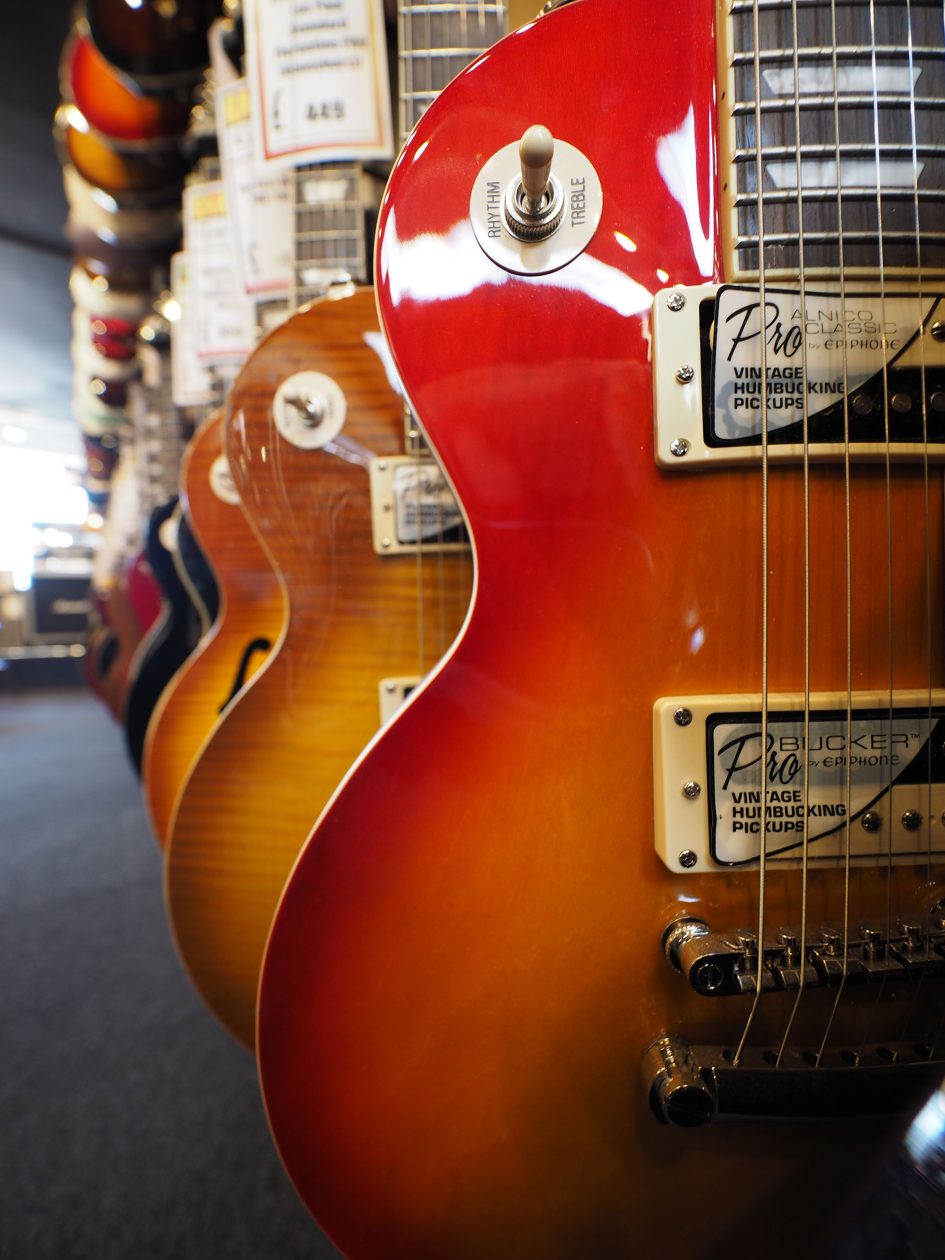
Above: 1/15, f2.8, 200 ISO, 7-14mm at 7mm (14mm equivalent)

Above: 1/320, f2.8, 200 ISO, 7-14mm at 7mm (14mm equivalent)
The optical construction of the Olympus 7-14mm f2.8 employs 14 elements in 11 groups (two Aspherical), compared to 16 elements in 12 groups (two Aspherical) on the Lumix G 7-14mm f4.
Both lenses employ seven rounded aperture blades, and closing either down to their minimum apertures of f22 will deliver 14 diffraction spikes. I’ve illustrated this below with photos from each lens, and while the spikes on the Olympus look a little better-defined in this example, the most important aspect to achieving the best result with an ultra wide at a tiny aperture is to keep the front element meticulously clean.

Above left: Olympus 7-14mm f2.8, above right: Lumix G 7-14mm f4. Both at 7mm f22
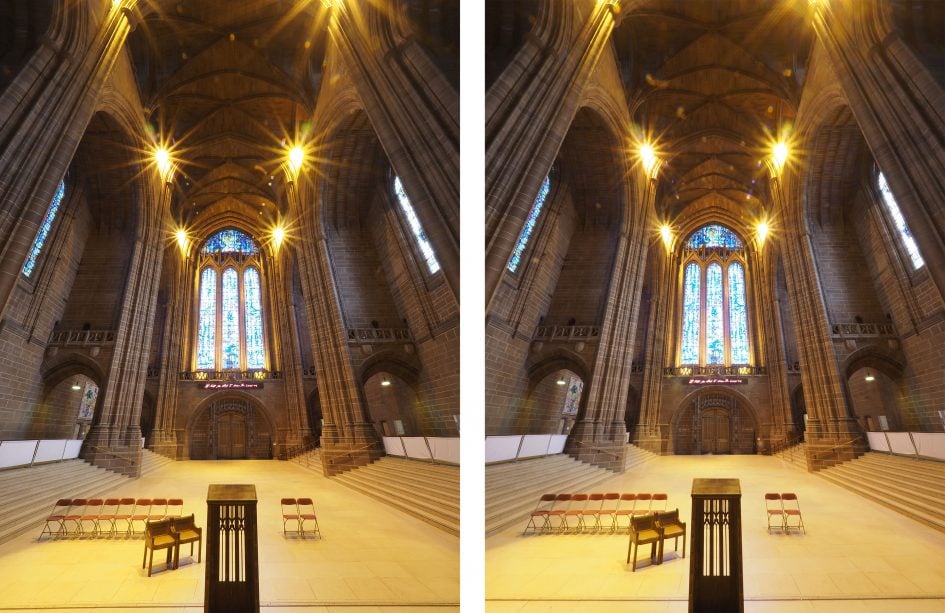
Above left: Olympus 7-14mm f2.8, above right: Lumix G 7-14mm f4. Both at 7mm f22
If you look close to the lights in the examples above, you’ll also notice some flare artefacts which brings me to one of the biggest issues with the earlier Lumix G 7-14mm f4 lens. As many of you know, the Lumix G 7-14mm is a wonderfully sharp lens, but one which can suffer from undesirable purple flare artefacts when compositions include saturated highlights, in particular strongly backlit windows from inside or bright streetlamps on a city nightscape. These artefacts are most obvious when the lens is mounted on Olympus bodies, but they’re also present on Panasonic bodies, just with a slightly less strong colour. I illustrated this in my OMD EM1 review where the same composition shot with the Lumix GX7 revealed the same flare artefacts in the same positions, but with a different intensity / colour.
The big problem with the flare on the Lumix G 7-14mm is it’s often hard to retouch-out and won’t go away when you stop the lens down either. So one of the biggest questions regarding the newer Olympus 7-14mm f2.8 lens is whether it suffers from the same flare issues.
To see how the two ultra wides handled the same scene, I photographed the interior of Liverpool Cathedral with both lenses mounted on the same OMD EM1 body within moments of each other, and at all apertures. You can see the full composition below, marked with a red rectangle indicating the area I’ve cropped.
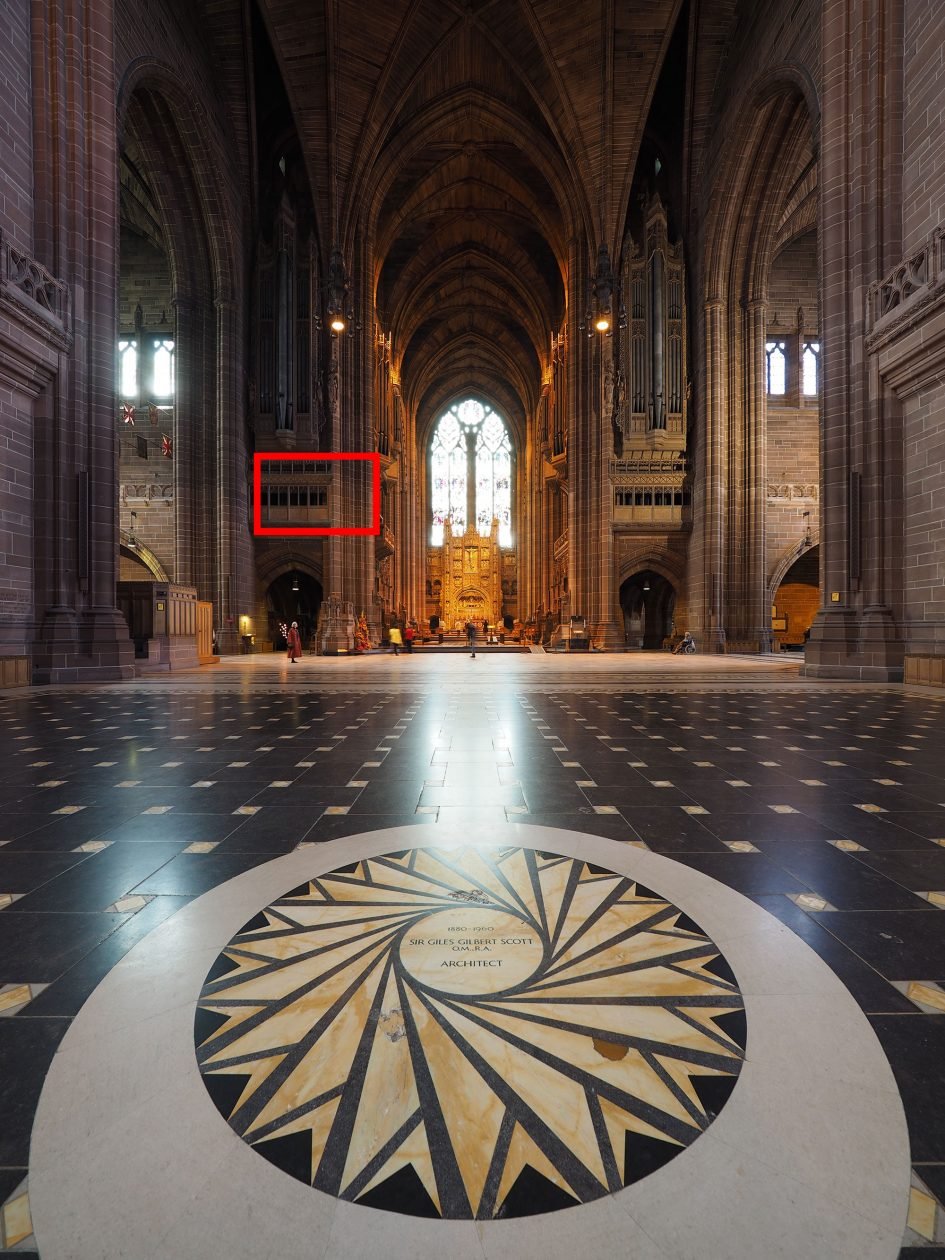
I’ve presented crops taken from the f4 versions of both below, and it’s clear the Lumix G 7-14mm sample is exhibiting the infamous flare artefacts while the Olympus 7-14mm avoids them.

Above left: Olympus 7-14mm f2.8, above right: Lumix G 7-14mm. 100% crops at f4
Once again the story remains the same at all aperture values. Closing the aperture on the Lumix lens sadly won’t fix this issue, so bonus points go to Olympus here, although as you’ll also see, they both look similarly sharp in the crop below. I’ve also looked-out for flare across the focal range of the Olympus and not found any yet, apart from when pointing directly at the Sun.
Now it’s time to check out how the lens performs in terms of sharpness across the frame! Check out my Olympus 7-14mm f2.8 quality results, or skip to my Olympus 7-14mm f2.8 sample images or back to my verdict!
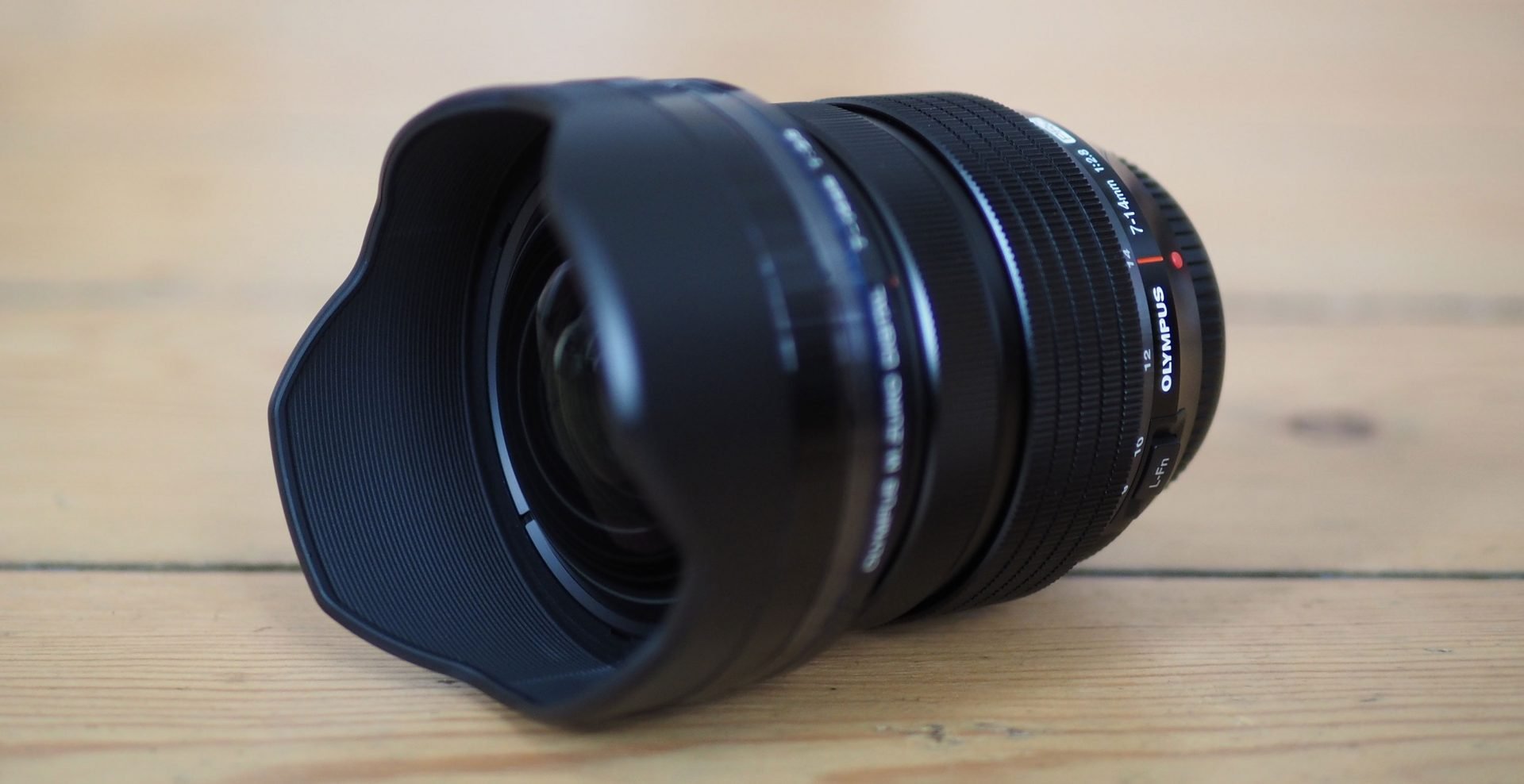
 The Olympus 7-14mm f2.8 Pro is a high-end ultra-wide angle zoom that delivers an equivalent range of 14-28mm with a constant f2.8 focal ratio. The range matches the coverage of the Lumix G 7-14mm, but it's a stop brighter and boasts weather-sealing too. Like the Lumix G 7-14mm, the built-in lens hood means there's no standard filter thread on the front, but third party solutions from the likes of Lee are available. The brighter aperture and tougher build means the Olympus 7-14mm f2.8 is inevitably larger, heavier and more expensive than the Lumix G 7-14mm, but it represents a step-up in all respects while also avoiding the purple flares that could plague the Lumix on some bodies.
The Olympus 7-14mm f2.8 Pro is a high-end ultra-wide angle zoom that delivers an equivalent range of 14-28mm with a constant f2.8 focal ratio. The range matches the coverage of the Lumix G 7-14mm, but it's a stop brighter and boasts weather-sealing too. Like the Lumix G 7-14mm, the built-in lens hood means there's no standard filter thread on the front, but third party solutions from the likes of Lee are available. The brighter aperture and tougher build means the Olympus 7-14mm f2.8 is inevitably larger, heavier and more expensive than the Lumix G 7-14mm, but it represents a step-up in all respects while also avoiding the purple flares that could plague the Lumix on some bodies.



